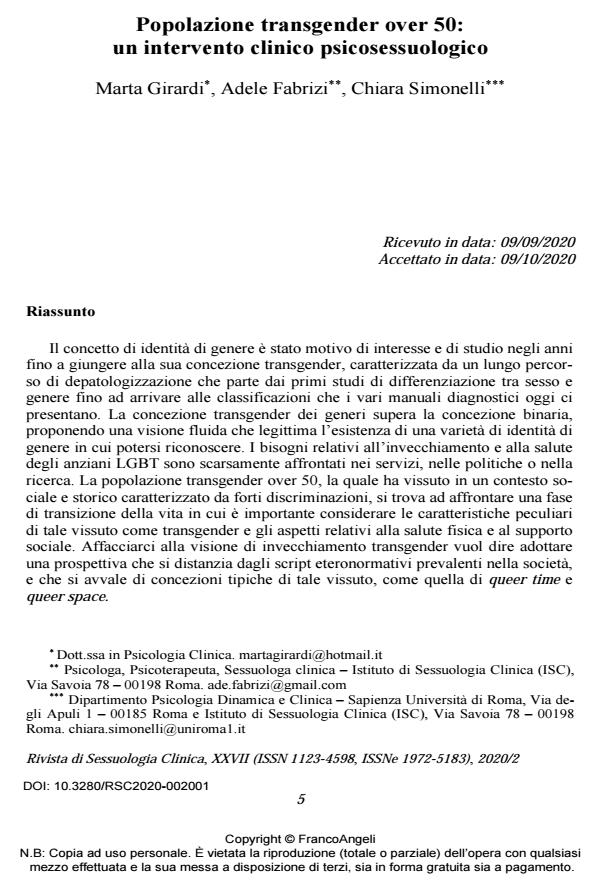Transgender population over fifty: a psycho sexological clinic intervention
Journal title RIVISTA DI SESSUOLOGIA CLINICA
Author/s Marta Girardi, Adele Fabrizi, Chiara Simonelli
Publishing Year 2020 Issue 2020/2
Language Italian Pages 18 P. 5-22 File size 224 KB
DOI 10.3280/RSC2020-002001
DOI is like a bar code for intellectual property: to have more infomation
click here
Below, you can see the article first page
If you want to buy this article in PDF format, you can do it, following the instructions to buy download credits

FrancoAngeli is member of Publishers International Linking Association, Inc (PILA), a not-for-profit association which run the CrossRef service enabling links to and from online scholarly content.
In recent years, the concept of gender identity has been under study until reaching the transgender concept which goes beyond the binary concept of sex and gender. It proposes a fluid vision that legitimizes the existence of a gender identity variety in which one can recognize itself. Therefore, the concept of gender identity goes through a long process of depathologization, as happened for exam-ple to the concept of "homosexuality" in previous years. This process starts from the first studies of differentiation between sex and gender and goes through the modern classifications that the many diagnostic manuals present us. The DSM-5 with its label of "gender dysphoria" emphasizes the personal distress associated with this condition, whilst the PDM-2 emphasizes its non-pathological dimension by naming it "gender inconsistency" while confining it in the appendix section. The health of the elderly LGBT population and their ageing-related needs have so far been poorly addressed in services, policies, or research. The understanding of this LGBT population life process cannot be separated from their social and historical life context that passed through the "Greatest Generation" and the one of the "Baby Boom", both characterized by strong experiences of discrimination and victimization. Moreover, talking about the transgender population over fifty, it faces a transition life phase in which one cannot ignore the peculiar characteristics of the experience as a transgender person and all the aspects related to the social support and the physical health. To look at the transgender ageing-perception means adopting a perspective that takes distances from the heteronormative scripts largely prevailing in the society, and that makes use of the typical concepts of this identity experience, such as queer time and queer space. For a broader understanding of the phenomenon is thus necessary to integrate two fundamental perspectives, the queer view and the gerontological one, contributing to the growth of awareness about ageing, identity, and human development. By adopting a health equity point of view, it is possible to identify the risk and protective factors that, on an individual level, have the greatest influence on the ageing process and psychological well-being. Among them, minority stress and resilience resulted to be the most relevant ones. On a physical level, during ageing, our body and mind can suffer from a grad-ual decline. Hormonal and surgical therapies for sex change can contribute to it and can represent some additional risks. To control this, the hormonal treatment is given following the Endocrine Society guidelines. The relationship between public health and transgender users has been characterized by a discriminatory climate that makes this population often reluctant to seek health care and negatively af-fect their physical health. Besides, also the social and family support that charac-terizes the transgender population over 50 influences their real and perceived well-being. Taking into consideration the issues concerning relations with public health, family reactions, as well as those encountered in the social sphere characterized by heavy prejudices, and the impact that all this has, it emerged the need to promote constructs such as health equity to overcome these problems and improve the liv-ing conditions of the transgender population. The goal of this contribution is hence to highlight the transgender population problems and needs in order to promote a clinician who is accurate and conscious of the peculiarities of the users and to support an ad hoc psychosexual clinical in-tervention adopting a biopsychosocial approach. The ultimate aim is to offer a service that is free from any heteronormative prejudice and binary conception of the genre, promoting the creation of a listening and analysis place in which the user can feel confident in exploring and expressing his needs and desires, which will be embraced and supported respecting his legitimacy and value.
Keywords: Gender identity, transgender, ageing, LGBT, psycho sexological clinic intervention, biopsychosocial approach.
Marta Girardi, Adele Fabrizi, Chiara Simonelli, Popolazione transgender over 50: un intervento clinico psicosessuologico in "RIVISTA DI SESSUOLOGIA CLINICA" 2/2020, pp 5-22, DOI: 10.3280/RSC2020-002001